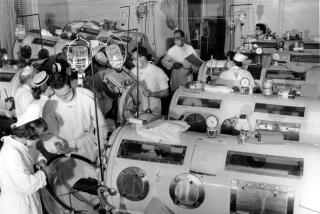Can Clinton Kick Quest for AIDS Vaccine Into Gear?
- Share via
President Clinton’s call for the accelerated development of an AIDS vaccine has a good chance of success, especially if he is able to stimulate an international effort, senior researchers say.
But scientific roadblocks may dictate radical new approaches, and even a full-bore international push might not meet Clinton’s 10-year deadline, they agreed.
“I believe we will have a vaccine,” said Anthony S. Fauci, director of the National Institute of Allergy and Infectious Diseases and the man most responsible for implementing Clinton’s vision. “I [just] don’t know when.”
“Ten years of intense effort could really make a difference,” said molecular biologist David Baltimore, incoming president of Caltech and the overseer of the National Institutes of Health’s AIDS vaccine programs. “If, in 10 years, we don’t have strong candidates, then we will have to wonder whether it is possible to make a vaccine at all.”
Researchers hope that Clinton’s push will kick the moribund vaccine research into a higher gear, and perhaps even stimulate trials of riskier but more promising approaches such as a live-virus vaccine. But they also caution that the research faces a number of stumbling blocks, including inadequate funding, economic disincentives for manufacturers and unsolved scientific problems.
Clinton’s challenge last week will definitely be harder to meet than John F. Kennedy’s 1961 pledge to place a man on the moon by 1970, said Luc Montagnier of France’s Pasteur Institute, co-discoverer of the human immunodeficiency virus that causes AIDS.
“Getting to the moon was a lot easier because it was applying technology that already existed,” he said.
AIDS researchers, confronting a virus that is almost unique in the annals of disease, are building their technology virtually from scratch.
A more pessimistic view came from Dr. Jean-Paul Levy, director of the French National AIDS Research Agency, who preferred to compare Clinton’s announcement to Richard Nixon’s declaration of a “war on cancer” 25 years ago.
“With cancer, there was an enormous amount of scientific uncertainties . . . and we are in much the same situation” with an AIDS vaccine, Levy said. “The Nixon project led to remarkable scientific results for all sorts of things, but it didn’t cure one cancer.”
If success is to be achieved in the 10-year window of opportunity, Montagnier said, it may require a “radical change” in research approach.
To date, AIDS immunologists have focused primarily on genetically engineered proteins from HIV, a tack that offers high safety for vaccine recipients but that has so far provided little protection for them. “In my opinion, [that approach] is at a dead end,” Montagnier said.
Pressed by the new deadline, researchers will have to begin thinking seriously about alternatives that carry a higher risk of study subjects developing AIDS or cancer but that also offer the chance for higher rewards.
Some immunologists are now thinking the previously unthinkable--using a weakened, but still highly dangerous, AIDS virus itself. Up until now, almost all vaccine trials have involved harmless proteins isolated from the virus.
“Clearly, [a live-virus vaccine] would not be acceptable [in the United States],” said Margaret Johnston, scientific director of the International AIDS Virus Initiative. “In populations of really high risk . . . it may be justified. But that’s not a decision I want to make.
“I’m optimistic,” said Johnston, especially if Clinton can get leaders of other nations to join in the vaccine crusade at this summer’s G-7 summit meeting. “We have a long way to go yet . . . and it’s going to take an international concerted effort to get us where we want to be.”
Dr. Edward Mbidde, an AIDS researcher from hard-hit Uganda, said: “For us, anything that will make a dent in the epidemic is worthwhile. If we just sit and wait . . . and see our people devastated, I don’t think we are doing our duty as a nation.”
Finding an AIDS vaccine “is the obligation of the whole world, not just the United States,” said Dr. Jose Esparza of the United Nations Program on HIV-AIDS. “The challenge now is for every country to match the commitment of President Clinton.”
Cost of Drugs Prohibitive for Many
With the advent of the triple-drug therapy that seems to be bringing HIV infections under control in the United States, many have questioned the need for the government to be involved in the quest for an AIDS vaccine. But the arguments for participation are compelling.
According to some studies, as many as 35% of those who are HIV-positive do not respond to triple therapy, which uses the new protease inhibitors in combination with two other drugs. And despite intensive efforts at public education and prevention programs, young men, and especially young women, continue to be infected at an alarming rate.
Furthermore, more than 90% of the world’s AIDS victims live in developing countries where the $12,000 to $15,000 yearly cost of triple therapy is prohibitive.
“And if we let the virus fester unabated in the poorest parts of the world, it may evolve into a more deadly strain,” said William Paul, director of NIH’s Office of AIDS Research.
Already, eight distinct variants of the virus, called clades, have appeared. The next new clade, Paul said, could be resistant to the protease inhibitors that are the primary components of triple therapies--and such variants could be carried easily to any part of the world by infected individuals.
The bottom line, most experts agree, is that it is in the United States’ best interest to develop an effective vaccine. “The best long-term hope for preventing AIDS in the United States . . . is the development of an effective vaccine,” said microbiologist Barry R. Bloom of the Albert Einstein College of Medicine in New York City.
Low Profits, High Risks for Vaccine Makers
Why doesn’t an AIDS vaccine exist today? One simple reason is economics. Vaccines, unlike drugs, typically don’t cost much to make, they don’t sell for a high price and they don’t make their manufacturers large profits.
They also carry the risk of giving their recipients the disease they are designed to prevent. About one in every million immunizations with the polio vaccine, for example, causes polio rather than preventing it, opening the producer to massive lawsuits.
The U.S. government, supported by a small tax on vaccines, has established a fund that shields companies from such liability, but HIV is explicitly excluded.
These problems “are tremendous disincentives,” Esparza said.
As a consequence, only four companies in the entire world now manufacture vaccines.
“If I owned a company, I would not invest in vaccine production,” said Seth Berkeley, head of the International AIDS Virus Initiative.
The agency hopes that increased funding by governments and agencies such as the World Bank, as well as guarantees to buy successful vaccines at fair prices, may lure more companies into the hunt.
At the same time, AIDS activists have shown little interest in vaccines. “The AIDS agenda is set in political terms by people who are HIV-positive,” said Dr. Susan Zolla-Pazner of the New York University Medical Center. “Their focus is treatment, not prevention.”
Consequently, of the $8 billion or so spent worldwide every year on AIDS, less than $200 million is devoted to vaccine research.
Clinton did not call for more money for vaccine research, but Fauci of the National Institute of Allergy and Infectious Diseases says that a good chunk of the proposed 2.6% increase in AIDS funds next year will be targeted in that direction. Fauci has always said that if NIH gets a good vaccine lead, it will pour whatever money is necessary into its development.
But some are concerned about where that money will come from. Jerome Soletti, a 36-year-old Parisian who is HIV-positive, spoke for many last week. Clinton’s declaration “makes me kind of angry,” he said. “What are the millions of people in the world who are already contaminated going to do?”
The scientific difficulties are perhaps even more daunting than the financial and emotional ones. HIV is unlike any other virus researchers have attempted to tame.
To begin with, it is a retrovirus, meaning that its genetic information is stored in the form of ribonucleic acid, or RNA, which is converted into deoxyribonucleic acid (DNA) in the host cell. Retroviruses have a more complicated, and potentially more dangerous, life cycle because their genes are incorporated into the host’s DNA, where they can cause cancer and other problems.
Researchers have developed effective vaccines against animal retroviral diseases such as feline leukemia, but never against a human retrovirus.
Furthermore, HIV’s target in humans is the immune system, the very tissue that should be shielding the body against invasion. Scientists do not yet know if that targeting short-circuits the immune response.
Historically, the first step in developing a new vaccine is to study people who have survived an infection, teasing out the immune components responsible for the recovery--the so-called correlates of immunity. That gives researchers a target during the early development of a vaccine.
But because no one has ever recovered from an HIV infection, no one knows what the correlates of immunity for HIV are. In fact, most of the conventional correlates of immunity--such as antibodies and killer T cells--are produced in people who are HIV-positive without having any significant effect on the course of the infection.
That is why some researchers are calling for the first large-scale field trial of a vaccine--any vaccine. If such a vaccine were to protect even a handful of people, Johnston argues, it would provide researchers a foundation on which to build more effective products.
Johnston believes the mysteries of HIV will be solved. “There is no reason to believe the scientific issues will be a show-stopper,” she said. “But we need to test vaccines in humans to learn more about them.”
One Approach Now Being Tested in U.S.
The beginnings of the first such trial occurred Thursday when National Institute of Allergy and Infectious Diseases researchers began testing a new strategy called “prime boost” in 420 Americans.
In one arm, participants receive an injection of a canary pox virus that has been genetically engineered to carry the genes for three proteins from the AIDS virus. Canary pox is harmless to humans and can carry the HIV genes into the body, where they stimulate the production of T cells that can destroy human cells infected by HIV.
In the other arm, participants receive a dose of genetically engineered proteins from the surface of HIV. This vaccine stimulates production of antibodies that seek out and destroy HIV itself.
Participants will receive four doses of each vaccine over a six-month period. It is hoped that the vaccines will stimulate the immune system to provide maximum protection against infection.
Prime boost is the largest U.S. AIDS vaccine trial to date. Although it is designed to prove the safety of the vaccines rather than their effectiveness, scientists hope that it will protect at least 10% of the recipients from infection by the AIDS virus and perhaps as many as 50%.
Ten percent protection, while disappointing, would provide some clues about the correlates of immunity that could help in the design of a better vaccine.
Fifty percent protection, which would represent a complete failure for a vaccine against virtually any other, less complex virus, would almost certainly trigger much larger trials in countries where AIDS is epidemic.
“If we had 50% protection, that would really be something,” Johnston said.
Even 20% to 40% protection “would save and extend millions of lives and would reduce secondary transmission to offspring and contacts,” Bloom added.
No one, however, believes that prime boost represents the long-term future of AIDS vaccines. The best hope, most agree, is to get several types of vaccines into human trials and see what happens.
“We have to explore as quickly as possible four or five paths at the same time,” Montagnier said. “And I think that among five, we will find one that is good.”
Two potential paths are currently most exciting, Baltimore said: naked DNA and weakened, live viruses.
Naked DNA vaccines entail the injection of DNA only, freed from all the proteins that normally surround and protect it in an intact virus. Research suggests that injecting the genes for viral proteins provokes a much stronger immune response than injecting the proteins themselves. The approach is being used experimentally for a number of other viruses, such as influenza, and seems to be producing good results.
Dr. David B. Weiner of the University of Pennsylvania reported last month that injections of naked DNA copied from the virus’ RNA successfully protected two chimpanzees from infection by subsequent high doses of HIV. The vaccine is now being tested in about 30 humans in Philadelphia and at NIH, and researchers have high hopes.
Historically, however, the best immunity has been produced using actual, intact viruses. But it is necessary to kill or weaken them first so that they do not produce the very disease they are designed to prevent. Preliminary experiments with killed HIV have not been very promising, but a killed-virus vaccine developed by Jonas Salk is being tested as a therapy for people who are HIV-positive.
Dr. Ronald Desrosiers of Harvard University has developed an attenuated strain of the monkey analog of HIV--called simian immunodeficiency virus or SIV. Two monkeys immunized with the weakened virus in 1989 are alive and well, despite being exposed to massive doses of SIV.
“After seeing this protection in monkeys, I became an advocate,” Desrosiers said.
Desrosiers and his colleagues have developed a weakened, or attenuated-HIV, vaccine and want to test it, but ethical concerns have restrained them. Scientists fear that, once in humans, the weakened virus would be able to regain its full strength.
Retroviruses in general are also known to cause cancer, and many fear that the risks of long-term exposure to even a mutant retrovirus are too high.
But nature has provided a strong hint that scientists’ fears may be exaggerated. At least one American and eight Australians have been found to be naturally infected by an HIV mutant similar to the SIV strain. Although two have subsequently died from other causes during the 15 years they have been observed, none have developed AIDS and none have developed suspicious cancers.
Desrosiers and others say now is the time to begin human tests of this HIV analog of the monkey vaccine.
Johnston says more animal research is needed, and the International AIDS Virus Initiative is funding the design of a large, long-term animal study of the attenuated virus to explore the concerns about hazards.
Baltimore noted that researchers in Australia “are explicitly talking about a human test” and that his group at NIH has discussed it recently as well. “But it is going to take some time. . . . The people who will administer it have to be reasonably confident that it is not going to do any harm.”
But time is running out, said John S. James, editor of San Francisco’s AIDS Treatment News. The live virus vaccine “ought to be tested.” And it won’t be hard to find a test group, he added. Many people at risk “have already volunteered, and it wouldn’t be hard to find others as well.”
Dr. Charles Farthing of the AIDS Healthcare Foundation in Los Angeles is talking about recruiting a group of doctors who would take the prototype vaccine. “We’ve got to be courageous,” he said.
Maugh reported from Los Angeles, Cimons from Washington and Dahlburg from Paris.
(BEGIN TEXT OF INFOBOX / INFOGRAPHIC)
How to Build an AIDS Vaccine
As many as three dozen potential AIDS vaccines have been developed in industry an academia. Most have proved extremely disappointing in their preliminary trials, but some still look promising. To make these vaccines, researchers incorporate different parts of HIV, the virus that causes AIDS. Many of the vaccines also incorporate adjuvants, chemicals that stimulate the immune system to help it respond to the viral component.
1. Chiron uses biotechnology to prepare a surface protein called gp120.
2. Pasteur-Merieux Connaught incoporates the genes for a surface protein called gp160, along with genes for two internal proteins called gag and protease, into canarypox virus.
3. Those two, together, are the vaccines used in the “primeboost” trials.
4. Apollon takes naked DNA produced from the virus’s own RNA and injects it directly into muscle.
5. Auragen takes similar DNA, coats it onto minute gold spheres, and uses a “gene gun” to shoot it into muscle.
6. British Biotech uses biotechnology to make internal proteins called p17 and p24.
7. Cel-Sci Corporation uses biotechnology to produce a fragment of the p17 protein.
8. Genentech uses biotechnology to produce a surface protein called gp120.
9. Imuno AG uses biotechnology to produce a surface protein called gp160.
10. MicroGeneSys incorporates the gene for gp160 into a weakened vaccinia virus.
11. Therion removes a gene called nef from HIV, then uses the entire virus.
12. Immune Response Corp. uses a dead virus.
Sources: Name here, Name here; Researched by NAME HERE / Los Angeles Times
More to Read
Sign up for Essential California
The most important California stories and recommendations in your inbox every morning.
You may occasionally receive promotional content from the Los Angeles Times.










